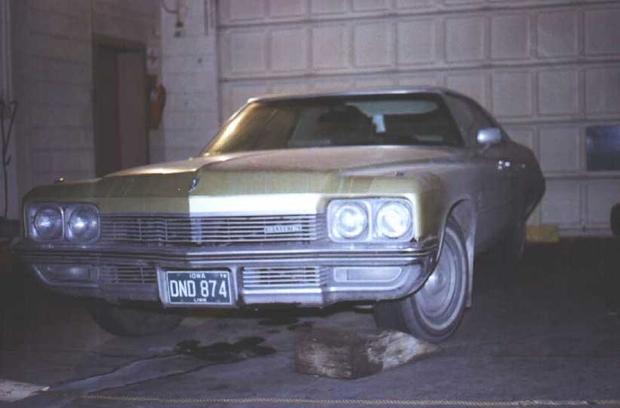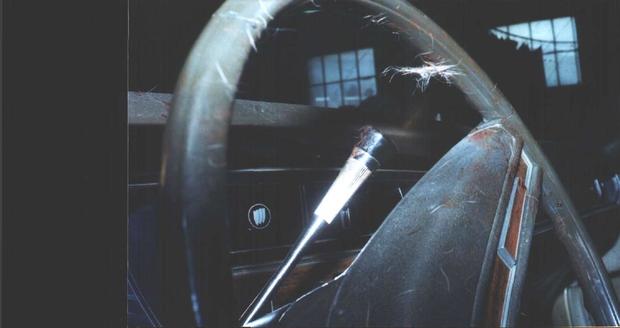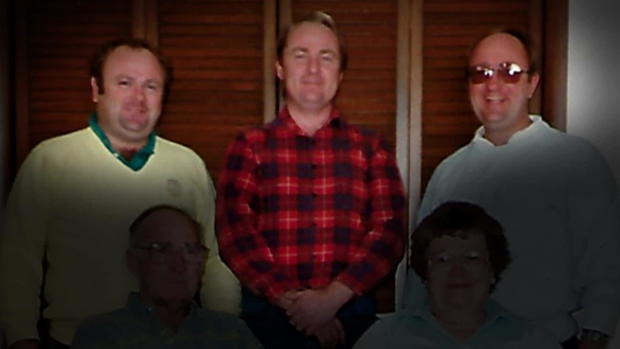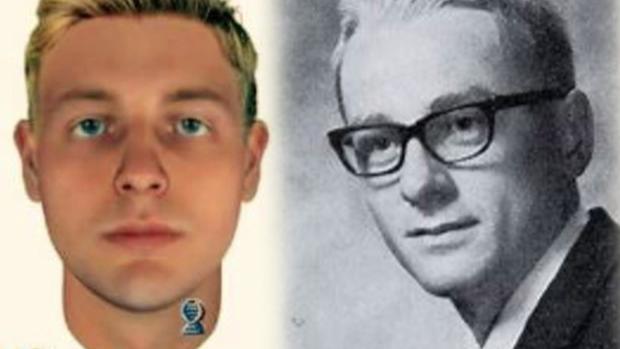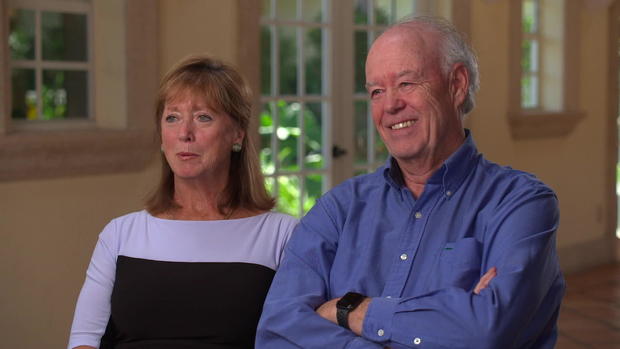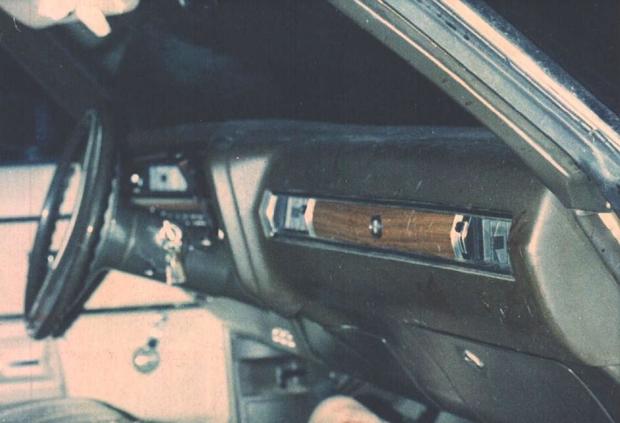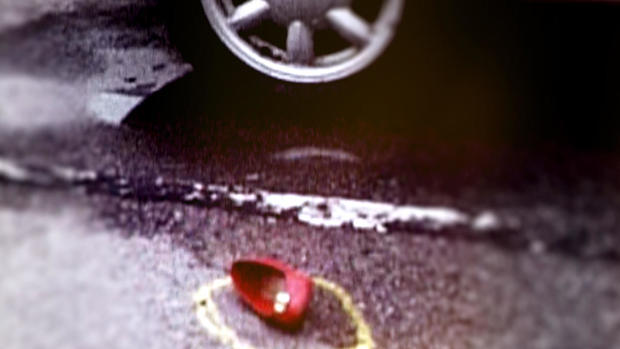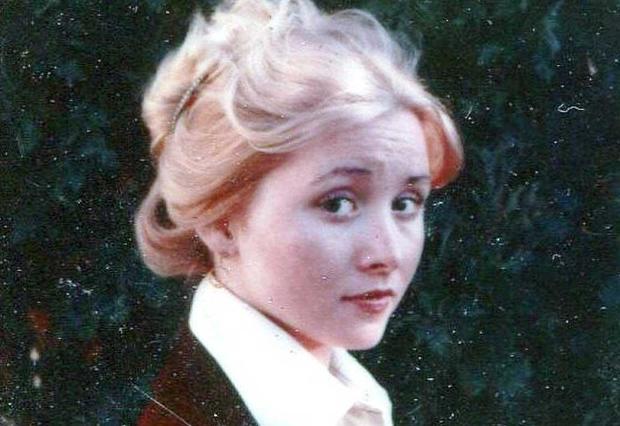Young murder victim helps solve her own cold case nearly 40 years later
[This story previously aired on November 7, 2020. It was updated on August 7, 2021.]
In the early hours of December 20, 1979, the body of 18-year-old Michelle Martinko was found in her car in the parking lot of a mall in Cedar Rapids, Iowa. She was stabbed multiple times. The murder baffled investigators for several generations. CBS News Correspondent Jamie Yuccas explores the unrelenting quest to solve one of Iowa's most haunting cases and how Michelle Martinko may have helped them solve her own murder.
A HORRIFIC SCENE
Just before Christmas in 1979, every single police officer in Cedar Rapids, Iowa, was called to work on the horrific murder in the parking lot of Westdale Mall -- including, now-retired Detective Harvey Denlinger.
Harvey Denlinger: I had never seen anybody stabbed that many times. ... Something like that was unheard of around here..
Michelle Martinko, an 18-year-old high school senior, had been found violently stabbed in the front seat of her car. Her killer was unknown, confounding generations of investigators.
Harvey Denlinger: We couldn't come up with anything … and we just kept plugging away.
Jamie Yuccas: How old were you?
Det. Matt Denlinger: I was 5 years old.
Jamie Yuccas: Do you remember the case?
Det. Matt Denlinger: No, not from when I was little.
Matt is Harvey's son.
Det. Matt Denlinger: But every single year on Dec. 19th … the local news would have a Michelle Martinko segment … So, it was really hard to miss the severity of it.
2006 NEWS REPORT: Michelle Martinko was a bright eyed, blonde … 27 years ago her life was cut short …
Decades later, Matt — now a detective himself — joined the investigation into Michelle Martinko's murder 36 years after his father had begun working the same case.
Det. Matt Denlinger: Wouldn't it be something if I could find our suspect and my dad is still alive?
And as he dug into the thick files, the son went to his father to help him make sense of it all.
Det. Matt Denlinger: I wanted someone to talk to about it and I wanted someone that really understood it.
The crime had stunned this small city of 110,000.
Tracy Price: It scared the hell out of us.
Tracy Price went to high school and sang in the choir with Michelle.
Tracy Price: It just hit me like a brick … Why? [shakes head]
Mike Wyrick [Shakes head]: It was just shocking.
Mike Wyrick had dated Michelle in high school, and says her murder shattered the city's All-American image.
Mike Wyrick: If that could happen and the person wasn't caught, anything could happen.
Janelle Stonebraker is Michelle's big sister — 12 years older. Michelle was the flower girl at her wedding. She and her husband John say nothing could have prepared them for the horrible news they got the morning after Michelle was killed.
Janelle Stonebraker: We just hugged and we couldn't believe she was gone. … my dad was very stoic about it, but he was angry. My mother was just brokenhearted [emotional].
It was a devastating blow to parents who had been through so much with Michelle already.
Janet Martinko had suffered five miscarriages and was 44 years old when Michelle was born.
Janelle Stonebraker: It was great, I mean, it was just so exciting when my sister was born … and she was the "miracle baby."
When she was 12, Michelle was diagnosed with scoliosis, a curvature of the spine. She had to wear a brace that went from her neck to her hips.
Janelle Stonebraker: She felt very different, very self-conscious. She couldn't move around like other kids could move around, so that was a tough period.
But at age 14, she was able to shed the brace and then, Janelle says, everything changed for Michelle.
Janelle Stonebraker: Farrah Fawcett was in with the hair and my sister always had the long blond hair. So, she thought, "OK, I can do the hair."
John Stonebraker: Michelle was blissfully unaware of all this attention she was getting from men.
She caught the eye of Andy Seidel, who, at 16, was a year older than Michelle.
Gail Dawson: We met him roller skating.
Michelle's friend Gail Dawson remembers him.
Gail Dawson: There was this flashy, sports car guy, you know.
Michelle and Andy were together for two years, and then broke up. Friends say she didn't want to be in a committed relationship—and Andy apparently didn't take it too well.
John Stonebraker: After they broke up, he wanted to know her every move, who she was dating, why she was dating that particular person. He would talk to her friends … he just wouldn't go away.
Police learned Andy had run into Michelle at the mall that fateful night. They brought him in for questioning.
Jamie Yuccas: Did he have an alibi?
Det. Matt Denlinger: Andy did have an alibi—Andy was at home shortly after the mall closed … and his mom provided an alibi. The problem with Andy's alibi though is that moms would say a lot to protect their children.
Gail Dawson: Every male that knew her was a suspect they had to clear.
Jamie Yuccas: You must have been a suspect?
Mike Wyrick: I was.
Mike Wyrick was questioned as well. And even though he was more than 100 miles away at college when Michelle was murdered, police knew he had also dated her.
Mike Wyrick: All of it was a little intimidating. It was hard. It was scary.
Mike says the police were tough on him.
Mike Wyrick: At one point they thought that I wasn't telling them everything, and they laid the crime scene photos out in front of me. And it was hurtful.
Mike was never considered a serious suspect because he was not in Cedar Rapids at the time of the murder — but Andy was. And Andy's behavior at Michelle's funeral only reinforced many people's suspicions about him.
Gail Dawson: He was almost in the casket. He was so emotional. He had his arms around her, and he was just sobbing …he said to me— "I have to know who she loved when she died. …Did she love me, or did she love Mike? Who did she love when she died?"
But police had no hard evidence pointing to Andy Seidel. He left Cedar Rapids soon after high school and joined the Navy.
Gail Dawson: There's a large amount of us that were convinced that he did kill her.
John Stonebreaker: I thought it was just a matter of time before he was arrested and charged.
Janelle Stonebreaker: There was no one else. There really wasn't another suspect.
BLOOD THE KILLER LEFT BEHIND
As police investigated those closest to Michelle Martinko looking for potential suspects, they were also looking at the possibility that Michelle may have been killed outside the mall by a stranger.
Tracy Price: She was out there, and she was looking for a coat that her mom had put on layaway for her for Christmas, and she was gonna pay it off.
Michelle had a $186 with her to pay for the coat, but ultimately decided she didn't want it. Tracy Price had run into her at the mall that night and gave her a protective warning when he saw her holding the cash.
Tracy Price: "Put that away," you know … "don't be flashing money out here in the middle of everybody. "
Tracy only learned later that Michelle was a little anxious that night.
Tracy Price: She was nervous about going out to the mall by herself and that she told someone she felt like she was being followed.
Jamie Yuccas: You didn't notice anybody watching her, paying close attention her?
Tracy Price: I never got that feeling.
Michelle headed to her car in the dark.
Jamie Yuccas: So, she was parked pretty far away.
Det. Matt Denlinger: Yeah, she was parked a ways out here. … I think she gets in, I think she turned that car on by herself and was warming it up to get the frost off the windows … and I think in that moment before she puts it in drive and leaves, he's at the door, pops it open, pushes her over and climbs in.
Jamie Yuccas: Sounds like a robbery?
Det. Matt Denlinger: On the surface it would sound like a robbery, but she did have the cash on her, it wasn't taken. She did have a bag with some items she had purchased in the back seat, those weren't taken.
Jamie Yuccas: So, is it a sexual assault?
Det. Matt Denlinger: It very well could have been the plan.
Although the autopsy showed she was not sexually assaulted, Michelle had defensive slice wounds on her hands and body.
Det. Matt Denlinger: You have to assume that pretty much any motive you can think of was a possibility and that Michelle decided she wasn't gonna allow that to happen. She fought.
Whatever the motive, the assailant had come prepared.
Det. Matt Denlinger: They found rubber glove indentations on the outside of the car in dirt. They found them inside the car in blood … it was clear that the person was trying to conceal their identity.
Investigators had no fingerprints, no witnesses and few leads. Although they had a blood-soaked crime scene, DNA technology was still years away.
Det. Matt Denlinger: It's frustrating -- by 1986 this case is sitting on ice, it's that cold … no one can think of anything more to do at that point.
Michelle's family was even more frustrated.
Janelle Stonebraker: It seemed that everyone had been looked at.
John Stonebraker: We thought the case was pretty much dead in the water.
It would take almost two decades, but the case would come alive again. In 2005, Detective Doug Larison was in charge. Coincidentally, he had gone to high school with Michelle. Although they weren't close, her murder had deeply affected him.
Jamie Yuccas: So that had been on your mind since you were 18 years old -- how do we get this solved.
Det. Doug Larison: Right. … I felt a responsibility toward my classmates actually to get this case solved.
In the years since Michelle's murder, DNA had emerged as a forensic tool.
Det. Doug Larison: Technology changes, science changes. … So, I wanted to proceed and move the case forward.
And Larison did just that. He was reading Michelle's file when he discovered that sometime earlier, another detective had sent blood scrapings found on the gearshift of the car out for testing. But nobody had followed up on the results.
Jamie Yuccas: And it just stays in the file until somebody finds it?
Det. Doug Larison: And it can get lost in the file.
Jamie Yuccas: … and until somebody sits down and reads the file do they go, "Oh wow, we have DNA. "
Det. Doug Larison: Those different investigators don't necessarily network with one other.
But Larison found that lab report, and it showed that not only did the gearshift have DNA, but it was male DNA.
Det. Doug Larison: He had probably cut himself and that's how his DNA and his blood got mixed with her blood in the gearshift selector.
Larison then sent Michelle's dress -- which had been safely tucked away in an evidence locker -- to the lab for further testing.
Jamie Yuccas: What did they find?
Det. Doug Larison: A spot of blood on her dress with a full male DNA profile. And it was consistent with the male DNA profiled on the gear shift selector.
Larison had identified a crucial piece of evidence.
Det. Doug Larison: I think it's just common sense that that's probably your killer right there.
Detectives had the lab work. Now, all they needed was the suspect.
Det. Matt Denlinger: We know we need just one person. We just need to get lucky. You know -- have the sun shine on us just one day when we find one person that matches that.
But it would take many days -- more than a decade. And it wasn't luck -- it was cops who wouldn't quit until they finally narrowed in on one very surprising suspect.
Janelle Stonebraker: So, we -- oh boy, this is it— we have finally gotten down to the wire on this.
SEARCHING FOR A SUSPECT
In America's heartland, for friends like Tracy Price who saw Michelle Martinko the last night of her life, for ex-boyfriend Mike Wyrick, and for close friend Gail Dawson, Michelle's murderer left a mark on all their lives.
Tracy Price: Every anniversary, it goes through your head.
Mike Wyrick: We were all victims in a way.
Jamie Yuccas: Your innocence was stolen.
Mike Wyrick: Yeah, exactly.
Gail Dawson: Then the fear set in. .. You're scared. You're afraid to go places.
The killer had vanished. But by 2005, investigators were onto something new: science and that male DNA profile on Michelle's dress and the DNA from the blood on her car's gear shift.
Jamie Yuccas: Would it be fair to say you found a needle in a haystack?
Det. Doug Larison: I think there's a lot of needles in a lot of haystacks in this case.
For lead investigator Doug Larison, old evidence suddenly had fresh potential. He shipped the blood samples to CODIS, the nationwide database of DNA collected from arrested offenders. If Michelle's murderer had a previous record …
Det. Doug Larison: … CODIS will give us a hit and tell us who matches the profile.
Jamie Yuccas: So, you send it to CODIS and what happens?
Det. Doug Larison: Well, we never got a hit.
It was a dead end. The DNA from Michelle's dress and car did not match up with anyone in the huge government file.
Det. Doug Larison: So, now we had a job to do.
Starting with locating all the people Cedar Rapids cops had originally interviewed.
Det. Doug Larison: We collected DNA samples from over 100 different people.
Cops had to convince them to take a DNA test.
Det. Doug Larison: It was time-consuming.
Mike Wyrick and Tracy Price were tested; both came up negative. At the top of Larison's list was Michelle's old boyfriend, Andy Seidel.
Det. Doug Larison: I think he was probably the main suspect from the very beginning of this case.
Andy Seidel had lived for 27 years with many in his hometown believing he was a killer.
Det. Doug Larison: I said, "listen Andy, if you give us your DNA, and it doesn't match. Then you're eliminated. You're cleared". … he voluntarily gave his DNA and he was eliminated.
But whoever ended Michelle's life, left a different, but lasting mark on Andy. Michelle's parents both died before that DNA test exonerated him. They likely went to their graves believing Andy was their daughter's killer.
Janelle Stonebraker: I feel really bad about that.
John Stonebraker: Andy was a victim himself because … many many fingers were pointing at Andy.
Larison moved on -- classmates, friends, family -- searching for a match with that male DNA.
Jamie Yuccas: So, you do a hundred people. What comes back?
Det. Doug Larison: Everybody's eliminated. No matches.
It had been 10 frustrating years for Detective Doug Larison.
Det. Doug Larison: I was kind of burned out. And so, I went to my supervisors and said, "I think you need to get somebody to replace me on this case." … And that's when Matt came in.
Matt Denlinger, Harvey's son, that second generation -- searching for Michelle's killer. In 2015 he took over as lead detective.
Facts hadn't changed. But DNA technology had once again advanced further, offering tantalizing possibilities.
Det. Matt Denlinger: We've got this DNA profile. How can we get more information from it? Can we find out eye color, hair color, race?
Denlinger reached across the country, to Virginia's Parabon NanoLabs.
Det. Matt Denlinger: And they said, "Yeah we know what you're trying to do. And guess what? We can make a picture of a potential suspect from that DNA sample."
Jamie Yuccas: Did you think that could be possible?
Det. Matt Denlinger: No, no. I had no good concept that that was possible. It sounded a bit sci-fi. … But I was ready to try. We had to do something.
The portrait was striking. Parabon called the technique "Snapshot." It put a face on a phantom.
Det. Matt Denlinger: What we learned from that is our suspect was probably a white male, blonde hair, blue eyes. And so, we had a press conference.
Investigators had narrowed down the suspect's genetics, but they did not know his age, or have a clue as to how he wore his hair. So different sketches were created, each with a different look.
A town hungry for justice, searched its memory for a match.
Jamie Yuccas: You get a lot of tip calls?
Det. Matt Denlinger: We got hundreds.
Jamie Yuccas: Any of them pan out?
Det. Matt Denlinger: It's every blonde haired, blue-eyed guy that ever walked the face of the earth and stepped foot in Iowa.
Jamie Yuccas: Are you just confused?
Det. Matt Denlinger: I was really confused. … And I did not know where to go next.
The answer came from an infamous, but totally unrelated case: California's so-called "Golden State Killer." Joseph DeAngelo was arrested in 2018, charged with a decades-long spree of serial murder and rape.
Det. Matt Denlinger: That was big news. That was big, national news then … I read the article and it talked about genetic genealogy.
Jamie Yuccas: And you went "bingo."
Det. Matt Denlinger: I went "bingo." Yep.
Genetic genealogy -- the charting of DNA, from one family member to another – a DNA family tree. Parabon was ready to test that same DNA one more time.
Det. Matt Denlinger: They said … we'll use the sample you already gave us for the Snapshot images. I said, "let's do it."
Parabon searched a public national database, called GEDmatch, of people who submitted their own DNA voluntarily to trace their own personal family trees.
Det. Matt Denlinger: And in July 2018, we got a report back from them. They said, "Good news. We found a relative of your killer."
Det. Matt Denlinger: Brandy Jennings is our gal in Vancouver, Washington.
Jamie Yuccas: She's the second cousin once removed.
Det. Matt Denlinger: Exactly.
Brandy Jennings, an office manager and single mom, was a distant relative to the male whose DNA was found on Michelle's bloody dress and car.
Jamie Yuccas: So, you start with her.
Det. Matt Denlinger: You start with her.
Denlinger spent months building Brandy's family tree all the way back to her great-great-grandparents.
Det. Matt Denlinger: We used genealogical records, birth records, gravestone records, anything we could find on the internet, anything we could find to fill in a bunch of these unknowns.
As more blood relatives of Brandy Jennings provided their DNA, a genetic puzzle filled in. And the detective reached out to Parabon once again.
Det. Matt Denlinger: And they recalibrated things and said, listen we think your best odds are these three brothers who live in Iowa.
Three brothers. All from Iowa. All likely sharing some DNA with the blood found in Michelle Martinko's car. A 38-year trail was heading straight back home.
Det. Matt Denlinger: Twenty minutes away. I was pretty excited about this one.
ZEROING IN
By October 2018, Detective Matt Denlinger's painstaking ancestry searches had narrowed the suspects down to three brothers in Iowa and all of them were still alive.
Det. Matt Denlinger: We immediately started doing research on these three brothers. They were Donald Burns, Kenneth Burns and … Jerry Burns
Denlinger and his team set up a plan. They would collect DNA samples from the brothers to see if any were a match, and they would do it without them knowing.
Jamie Yuccas: You think one of them is a suspect, you can't tell any of the three.
Det. Matt Denlinger: Not only can I not tell any of the three, but I was careful who I told in general. … Iowa is not the biggest state in the union. And you never know who knows who.
They followed one brother to lunch and grabbed his straw; for the second, a toothbrush was collected from his garbage. And then the third brother, Jerry …
Det. Matt Denlinger: We drove up to Manchester. And we had already established kind of a pattern or some locations to try to find him.
After a couple of hours, he spotted Jerry Burns at a pizza restaurant.
Det. Matt Denlinger: He drank at least two sodas out of a glass with a straw.
All three brothers' samples were sent to the lab. Don and Kenneth were not a match, but the results showed Jerry Burns was an exact match. For Denlinger the message was clear.
Det. Matt Denlinger: I was definitely speechless. I'm almost speechless today thinking about it.
It turns out that Parabon sketch of the suspect was very similar to a young Jerry Burns. But Burns wasn't an obvious suspect.
Det. Matt Denlinger: We are not finding any ... connection to Michelle. No connection to that car.
Even more baffling, Jerry Burns' resume was the opposite of a cold-blooded killer. He had no criminal record and was even a respected businessman with a wife and three kids. Denlinger picked a particular day to interview Burns at his business: December 19, 2018 -- exactly 39 years to the day after Michelle was murdered.
Det. Matt Denlinger: I wanted to rattle him. I wanted to bring that up during the interview and see if that would do anything to him.
DET. MATT DENLINGER: Hey, how are you today? Jerry, my name's Matt with the Cedar Rapids Police Department.
Using a hidden camera inside a coffee mug, Denlinger tried to get a confession.
DET. MATT DENLINGER: The reality is we have your DNA at the crime scene, and so we know you were there that night this happened. … How would we get your DNA at the crime scene there, Jerry?
JERRY BURNS: I don't know.
But Jerry acknowledged he had been to the mall with his family in the past.
DET. MATT DENLINGER: Did you go to Westdale Mall?
JERRY BURNS: Oh yeah. We've gone to Westdale Mall, sure.
Although Jerry couldn't remember when he was at the mall, Denlinger continued to press him.
DET. MATT DENLINGER: Jerry, what happened that night?
JERRY BURNS: I don't know.
Despite Burns' denials, the DNA was enough to arrest him for the murder of Michelle Martinko.
On the ride back to Cedar Rapids, a camera was rolling again -- this time in the police car, and Denlinger believes Jerry offered something revealing.
Det. Matt Denlinger: Well, he said a few things … about blocking stuff out -- traumatic events.
DET. MATT DENLINGER [in back of police car]: Do you think it's possible this happened and you don't remember any of it?
JERRY BURNS [in back of police car]: I'm sure something like that would be … Be possible to block out … you block things out of your memories.
Jamie Yuccas: You're a homicide detective. Your gut tells you something. What does your gut say?
Det. Matt Denlinger: My gut told me the second he refused to deny it or give me a plausible explanation that we had the right guy.
For Michelle's sister Janelle, news of the DNA match and the arrest signaled hope and a day she and her husband John thought would never come.
Janelle Stonebraker: We were just whooping and hollering, and we were just talking and talking. We were just so excited.
But for the Burns family it all came as a complete shock. Jerry's daughter Jennifer and his brother Don couldn't believe the man they know and love could ever be capable of such a gruesome act.
Jennifer Burns: We did not believe it. This cannot be our dad.
Donald Burns: He couldn't have done it. There was just no way. He was always there for his family.
Leon Spies: Circumstances just made it highly improbable from our perspective. First of all, there was no connection between Jerry and Michelle Martinko. None.
Leon Spies is Jerry Burns' attorney. He believes his client's demeanor during the police interview wasn't out of the ordinary.
Leon Spies: I challenge anybody to predict how any person is going to react, let alone react to being caught out of the blue with an investigator trying to attribute them to a horrible, horrible crime. … he did not commit this murder.
In February of 2020, Michelle Martinko's accused killer went on trial more than four decades after her murder. Due to the buzz surrounding the case in Cedar Rapids, the judge granted a venue change to Davenport, Iowa, an hour away.
NICK MAYBANKS [in court]: The evidence will show that Michelle Martinko was murdered that night by the defendant, Jerry Burns.
Prosecutor Nick Maybanks felt the weight of his hometown on his shoulders.
Nick Maybanks: There's a lot of eyes on this case. … There are generations that grew up with this story.
And the generation who lived through the horror and suspicion. Several of Michelle's friends were called to testify, including Michelle's ex-boyfriend and once prime suspect Andy Seidel, who says he and Michelle were on good terms the last time they saw each other.
ANDY SEIDEL [in court]: There was no reason for us to part ways in a bad way … We just kind of grew apart as we evolved growing into adulthood.
Mike Wyrick was also called and had to relive Michelle's murder all over again.
Mike Wyrick: This trial was hard on me. … for a lot of us brought it all back into focus in a way that it hadn't been in focus since those early, early days.
From the start, the prosecution faced a number of hurdles. The case and the evidence were decades old.
Nick Maybanks: Try to take 40 years of investigation and condense it into a story.
And a lot of things about this suspect didn't make sense.
Jamie Yuccas: What's that like for you? You have a suspect who has no criminal background that we're aware of, and this heinous crime that looks extremely personal. You have no story.
Nick Maybanks: I don't. Yeah. And after he was interviewed, we didn't have much of a story, either.
A story the Burns family believes was problematic from the start.
Jennifer Burns: They wanted an explanation of how his DNA got there. Well, how is he supposed to know from 40 years ago? You know, I can't remember what I did last week every day.
Jamie Yuccas: So, would you say it's impossible that Jerry murdered Michelle?
Don Burns: I'd say it is. There's absolutely no way it could have happened.
Jennifer Burns: I don't think there's any way that my dad could have done this.
The prosecution's case hinged on that one critical piece of evidence: Jerry Burns' DNA.
Nick Maybanks: We've got the science; we got the guy. … There's a one in 100 billion chance that it could be somebody else's. There's only 8 billion people or so in the world.
But Leon Spies argues the DNA evidence isn't foolproof.
Leon Spies: There's lots of misconceptions about DNA … It's not the silver bullet that law enforcement often portrays it to be.
CURIOUS COMMENTS
As the state's case wound down, Prosecutor Nick Maybanks had one last card to play. He called a new witness, Michael Allison, a drug offender who had become friendly with Jerry Burns in jail.
MICHAEL ALLISON: I asked him directly –I asked him, "Jerry did you do the crime" and he said, "I can't talk about this."
But Burns did say something curious.
MICHAEL ALLISON: He feels like no matter what happens in his case that he wins, because he had the opportunity to be out there with his family all these years.
Allison said Jerry later made another comment while they were playing cards that disturbed him so much, he volunteered to testify.
MICHAEL ALLISON: He told me if I keep beating him at pinochle, "he was going to have to take me to the mall." … It disgusted me.
In his defense case, Leon Spies calls only one witness-- Dr. Michael Spence, a molecular biologist. He says while there is no doubt the DNA in Michelle's car belonged to Jerry Burns, how it got there was another matter.
LEON SPIES: Is it Dr. Spence, a plausible explanation, that the DNA of Jerry could have come about by a transfer?
DR. MICHAEL SPENCE: Yes, that's a distinct possibility.
Leon Spies: Every time you come into contact with something, you're shedding DNA, you're leaving a biological trail of yourself.
Leon Spies: She was in a shopping mall before she was killed, a shopping mall that the Burns family had used … she sat down with a friend at a food court -- a food court that Jerry Burns and his family may have sat at.
But how did Jerry's DNA end up on the Buick's gear shift? Jerry's brother Don Burns believes there could be an innocent explanation.
Don Burns: He worked in the dealership that sold Buick cars. … so there is a possibility that if records show that that car went through that dealership, his DNA could be in that car.
But Det. Matt Denlinger isn't buying it.
Det. Matt Denlinger: My question for them would be, did the dress go to the dealership too? … This is fantasy world ... common sense says that's not the case.
Jamie Yuccas: Impossible.
Det. Matt Denlinger: Impossible.
In his final arguments, Prosecutor Maybanks tells the jury there was only one way Jerry Burns' DNA got into that car.
NICK MAYBANKS: There was no chance of outside contamination on this dress. We know how it happened and we know who did it.
In his closing argument, Spies attacks the integrity of the investigation.
LEON SPIES: You can consider not only the evidence but also the lack or failure of evidence produced by the prosecution.
And he tells jurors to consider how unlikely it is that a man like Jerry could commit a crime like this.
LEON SPIES: The state's scenario here is that Jerry Burns, a married man with two young children at home, leaves, drives to Cedar Rapids, Iowa, in the night, leaving his wife and children behind, armed with a knife, armed with rubber gloves, goes to Westdale Mall on the chance that he's gonna encounter Michelle Martinko, decides to kill her … and then leaves and drives back home ... Splattered with blood … presumably with a knife wound in his hand … that's the scenario the government wants you to believe.
The jury begins deliberations on a Monday afternoon. Nerves are on edge.
Janelle Stonebraker: I was not thinking slam dunk … all it takes is one juror to have a hung jury.
But just three hours later …
John Stonebraker: I said – "we have a verdict!" We rush into the courthouse, sit down [simulates breathing hard], and then we wait.
JUDGE [reading verdict]: We the jury find the defendant Jerry Lynn Burns guilty of the charge of murder in the first degree.
Guilty. The courtroom was silent.
Janelle Stonebraker: We almost couldn't breathe … it was just amazing, it was fabulous.
Janelle Stonebraker: We were aware of how quiet it was on Jerry's side and that there was no reaction.
Jennifer Burns: Unfair.
Don Burns: I'd say I was stunned. The verdict came back so fast. I don't know if the jury took time to look at the facts.
Jamie Yuccas: What do you feel in that moment?
Det. Matt Denlinger: Extreme relief … the weight of the world was off my shoulders now.
Harvey Denlinger, the investigator who was there at the beginning of the case 40 years earlier, saw his son help end it.
Harvey Denlinger: I'm proud as heck of him.
Det. Matt Denlinger: I really am proud to get an answer while he can still appreciate it.
Jamie Yuccas: He said today how proud he is of you.
Det. Matt Denlinger: Yeah, alright – [tears up] -- we're gonna take a break.
Finally, there was an answer to the question that had haunted Cedar Rapids for so long. But there is a lingering question: was Michelle Martinko Jerry's only victim?
JERRY BURNS: I just seen something about Jodi Huisentruit recently …
In his interview with Denlinger, Burns randomly mentioned the name of Jodi Huisentruit. She was a blonde anchor kidnapped near her car in a parking lot in 1995 and never found. She worked in Mason City, Iowa, two hours from where burns lived —though there is no evidence he knew her.
Jamie Yuccas: Do you suspect that Jerry Burns was involved in other crimes?
Det. Matt Denlinger: I don't know the answer to that … my gut tells me there's probably something else out there.
Mason City Police will not disclose whether they are investigating Burns in the Huisentruit disappearance and his DNA is not connected to any other cases. But in Michelle Martinko's case, she played a unique role in revealing her killer.
Janelle Stonebraker: She fought so hard that she caused the murderer to cut himself, he left his DNA … and so Michelle helped solve her own murder.
Four decades after Michelle's death, her friends, family and generations of investigators gather to celebrate her memory.
Nick Maybanks [at the gathering]: This case isn't just about her death it's about her life.
Gail Dawson: Nick Maybanks worded it best, I mean he said, "it's not about how she died, it's about how she lived."
Tracy Price: You can't help but wonder, where would life have led her?
Her name will be forever etched in local history, as part of Cedar Rapids' most haunting crime.
Jamie Yuccas: you've been a prosecutor for 20 years is this the biggest case you've ever had?
Nick Maybanks: Yeah … every case you want justice … but a case like this touched so many people over so many years there will never be another one like it.
Jerry Burns was sentenced to life in prison without parole.
He insists he did not murder Michelle Martinko.
Produced by Alec Sirken, Jamie Stolz and Matthew Goldfarb. Lincoln Farr is the development producer. Ken Blum, Doreen Schechter and Michelle Harris are the editors. Lourdes Aguiar is the senior producer. Nancy Kramer is the executive story editor. Judy Tygard is the executive producer.



